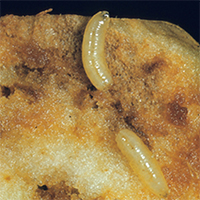
OLYMPIA – A new report released today pegs the economic impact of 23 of the most damaging invasive species in Washington at $1.3 billion a year and a loss of 8,000 jobs, if there’s no prevention, according to the Washington Invasive Species Council.
“Invasive species are plants and animals not native to Washington, and once they land here, they out-compete existing wildlife,” said Justin Bush, executive coordinator of the Washington Invasive Species Council. “They can wipe out crops, clog waterways, damage pipes and dams and completely change the landscape and the wildlife that live there. Left unchecked, invasive species can ring up huge costs for control, kill jobs and harm our economy.”
While there are more than 200 known invasive species found in or near Washington state, the economic analysis highlights the damages and potential impacts that could result if 23 of these species were allowed to spread in Washington in a single year.
Following are the total potential economic impacts of 23 invasive species on Washington’s industries:
Crops: Cropland has the potential to be quickly infested by invasive plants, which require resources to control, and by invasive animals, which are looking for fruits and vegetables to eat. The total economic impact of the selected 23 invasive species on crops grown in Washington is estimated to be more than $589 million a year and 4,400 jobs lost.
Timber: Many invasive species have the ability to severely impact Washington’s
$1.68 billion timber and logging industry. Invasive noxious weed species such as Scotch broom can outcompete new saplings, which harms future timber harvests. Insect species such as gypsy moth have a more immediate impact on forests by defoliating and stressing adult trees, resulting in their death. The total economic impact of the selected 23 invasive species on the timber industry is estimated to be $297 million and 1,300 jobs lost.
Livestock: Invasive noxious weeds in pastures and rangeland displace native plants eaten by livestock. In some cases, these plants also are poisonous to livestock and horses and can cause life-threatening ailments. The total economic impact of the selected 23 invasive species on the livestock industry is estimated to be more than $282 million annually and 1,500 jobs lost.
Recreation: Recreational activities such as hunting, fishing, and boating can all be adversely affected by invasive species. Many of the same species that impact a rancher’s ability to range their cattle also reduce elk and deer populations. Invasive species in the water hamper fish populations and can reduce access to popular fishing areas. Other water species can clog boat motors and render public boat launches unusable. The total economic impact to recreational activities from the selected 23 invasive species is estimated to be more than
$47 million a year and 500 jobs lost.
Water Facilities: Water facilities such as dams and irrigation systems can be devastated by aquatic invasive species such as Eurasian watermilfoil and quagga and zebra mussels. If invasive species are introduced to a facility, costly mitigation and maintenance systems must be installed for the facility to function. The total economic impact to water facilities from quagga and zebra mussels is estimated to be more than $100 million and 500 jobs lost.
The Worst Offenders
Rush skeletonweed, Scotch broom, apple maggot and zebra and quagga mussels are the most costly of the selected invasive species in Washington with an estimated total impact of more than $927 million and 5,140 jobs lost, the report concluded.
“Invasive species, including noxious weeds, affect all of us in Washington,” says Alison Halpern, the executive secretary of the Washington State Noxious Weed Control Board. “Many people have probably seen Scotch broom take over a vacant lot, knapweeds crowd out rangeland plants or Eurasian milfoil plug up a lake and make it hard to swim or boat. It’s important to understand that not only are they reducing native plant diversity and degrading important habitat, but they also can really hurt businesses that rely on Washington’s natural resources.”
Invasive species rapidly colonize new areas, displacing native species. Nationally, the impacts of invasive species and control efforts cost more than $137 billion annually but information on the specific costs of these impacts in Washington has been lacking.
To address the lack of information, the Washington Department of Agriculture, Washington State Noxious Weed Control Board and the Washington Invasive Species Council partnered with five other state agencies (Departments of Ecology, Fish and Wildlife, Natural Resources and Transportation, and the Washington State Parks and Recreation Commission) to hire Seattle-based Community Attributes Inc. to quantify the impact of 23 of the most damaging invasive species in Washington. The analysis gathered information on crops, livestock, timber and recreation such as hunting, fishing and boating.
“This economic damage can be reduced or even prevented by controlling noxious weeds, reporting invasive species, choosing non-invasive plants, never releasing unwanted pets into the wild and cleaning recreational equipment before and after use,” Bush said. “We all must do our part to prevent the introduction of invasive species to Washington state. With this amount of revenue and jobs on the line, we can’t afford to ignore this important issue.”
“As this report makes clear, invasive species can devastate the economy, in addition to our state’s environment,” said Jim Marra, pest program manager for the Washington State Department of Agriculture. “This is all the more reason for our agency and our partners to continue the invaluable work of preventing the introduction of invasive species to protect the state’s agricultural, environmental and other natural resources.”












